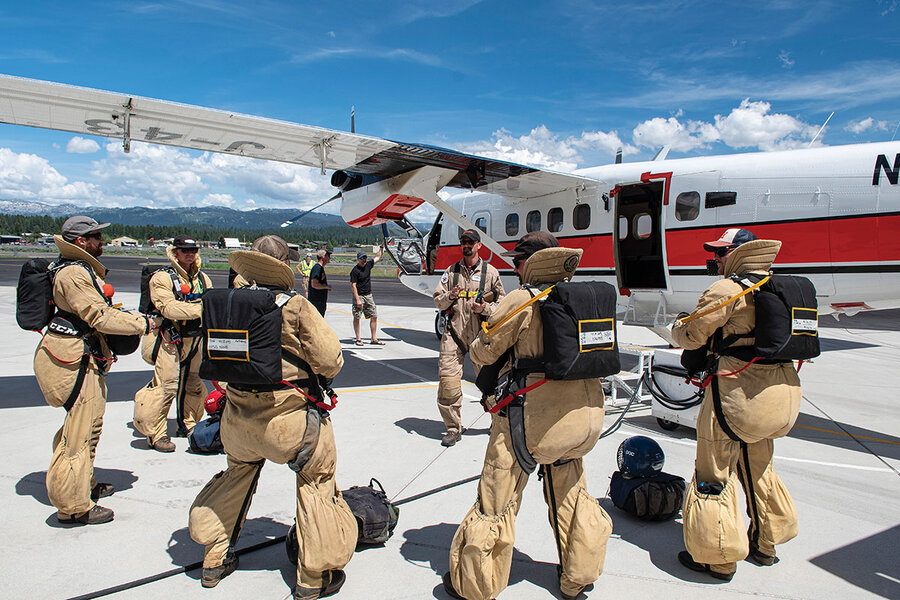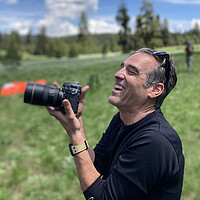Your subscription makes our work possible.
We want to bridge divides to reach everyone.
Subscribe

McCall smokejumpers conduct a final briefing with their pilot before boarding a plane for a mission in California.
Quick Read
Deep Read ( 2 Min. )

July 19, 2023
|
McCall, Idaho
Smokejumpers are a special breed of firefighter. In addition to being physically fit, they must learn how to read the weather and jump safely out of planes into scorching wildfires.
On a recent morning at McCall Smokejumper Base in Idaho, the team gathers for the daily weather report. This is not your typical TV news fare. With charts and graphs, the report goes in-depth on wind speed, humidity, pressure, conditions on the ground, and an array of other data.
Why We Wrote This
A story focused on
It takes courage, training, and teamwork to make it as a smokejumper. Rookies become adept at reading the weather, rigging gear, and landing softly.
Then the smokejumpers pile into two planes to practice their skills parachuting into a meadow. Each team has a spotter who determines the release point from the plane. Later, when the crews are back on the ground, the jumps will be rated for accuracy and, more importantly, soft landings. No fire jumper wants to be injured on the drop into a conflagration.
Smokejumpers have to be ready at a moment’s notice for dangerous assignments in far-flung locations. For newbies, the training is rigorous and taxing.
When asked why rookies are pushed so hard, operations foreman Brent Sawyer smiles and says, “We just want to make sure they want to be here.”
As a new morning starts, the McCall Smokejumper Base in Idaho is already in full swing. Rookies are being put through the wringer, doing pushups and pullups to the tune of trainers shouting, “What do you want to be?” When I ask operations foreman Brent Sawyer why rookies are pushed so hard, he smiles and says, “We just want to make sure they want to be here.”
At the same time, the operations desk gathers the rest of the smokejumpers for the morning weather report. This is not your typical TV news fare. With charts and graphs, the report goes in-depth on wind speed, humidity, pressure, conditions on the ground, and an array of other data that I can’t follow. As the smokejumpers listen, I almost see a spark of hope in their eyes for the opportunity to jump a fire. If I were to describe the typical smokejumper, I would say he or she is a combination of a special ops soldier, a tailor, and a ski bum.

Rookies perform pullups as part of their daily training.
This morning, smokejumpers pile into two planes to practice their skills by jumping into the meadow below, where the landing spot is marked with a small flag. Each team has a spotter who determines the release point from the plane. Later, when the crews are back on the ground, the jumps will be rated for accuracy and, more importantly, soft landings. No fire jumper wants to be injured on the drop into a conflagration.
Why We Wrote This
A story focused on
It takes courage, training, and teamwork to make it as a smokejumper. Rookies become adept at reading the weather, rigging gear, and landing softly.
Back at the base, there is no idle moment. All the parachutes that have been deployed must be meticulously inspected for rips and defects, and every single line must be checked individually. From this point, the chute goes either to the repair shop or to be rigged. The art of rigging, which demands full-body action and intricate folding, is a combination of sumo wrestling and origami-making. This goes on for hours.
At the end of a long day, the sun starts to hide behind the snowcapped mountains.
I drive off the base and see a small group of runners on the side of the road. One of them sings out, “What do you want to be?” and the rest reply, “Smokejumpers!”

A crew member performs a practice jump from 3,000 feet onto a target near the McCall Smokejumper Base in Idaho, June 7, 2023. The U.S. Forest Service maintains nine smokejumper bases located near wildlands, where vast distances and lack of roads make fighting backcountry fires extremely difficult.

Mike Fischer checks parachutes hanging in the tower, where the equipment is suspended to dry.

Kelly Matthews rigs a parachute. Equipment is thoroughly checked and repacked after each deployment.

Kelly Matthews (right) reacts after being selected to go on a firefighting mission to California.
You’ve read of free articles.
Subscribe to continue.
Help fund Monitor journalism for $11/ month
Already a subscriber? Login

Mark Sappenfield
Editor
Monitor journalism changes lives because we open that too-small box that most people think they live in. We believe news can and should expand a sense of identity and possibility beyond narrow conventional expectations.
Our work isn’t possible without your support.
Unlimited digital access $11/month.
Already a subscriber? Login

Digital subscription includes:
Unlimited access to CSMonitor.com.
CSMonitor.com archive.
The Monitor Daily email.
No advertising.
Cancel anytime.
Dear Reader,
About a year ago, I happened upon this statement about the Monitor in the Harvard Business Review – under the charming heading of “do things that don’t interest you”:
“Many things that end up” being meaningful, writes social scientist Joseph Grenny, “have come from conference workshops, articles, or online videos that began as a chore and ended with an insight. My work in Kenya, for example, was heavily influenced by a Christian Science Monitor article I had forced myself to read 10 years earlier. Sometimes, we call things ‘boring’ simply because they lie outside the box we are currently in.”
If you were to come up with a punchline to a joke about the Monitor, that would probably be it. We’re seen as being global, fair, insightful, and perhaps a bit too earnest. We’re the bran muffin of journalism.
But you know what? We change lives. And I’m going to argue that we change lives precisely because we force open that too-small box that most human beings think they live in.
The Monitor is a peculiar little publication that’s hard for the world to figure out. We’re run by a church, but we’re not only for church members and we’re not about converting people. We’re known as being fair even as the world becomes as polarized as at any time since the newspaper’s founding in 1908.
We have a mission beyond circulation, we want to bridge divides. We’re about kicking down the door of thought everywhere and saying, “You are bigger and more capable than you realize. And we can prove it.”
If you’re looking for bran muffin journalism, you can subscribe to the Monitor for $15. You’ll get the Monitor Weekly magazine, the Monitor Daily email, and unlimited access to CSMonitor.com.
Read this article in
https://www.csmonitor.com/USA/Society/2023/0719/In-Pictures-The-smokejumpers-of-McCall-Idaho
Start your subscription today
https://www.csmonitor.com/subscribe
>>> Read full article>>>
Copyright for syndicated content belongs to the linked Source : The Christian Science Monitor – https://www.csmonitor.com/USA/Society/2023/0719/In-Pictures-The-smokejumpers-of-McCall-Idaho?icid=rss































